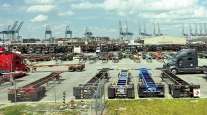Intermodal Shipments Up 5.8% to 3.48 Million; Highest 1st-Quarter Total on Record, IANA Says
This story appears in the May 14 print edition of Transport Topics.
Accelerating domestic demand pushed up first-quarter rail/truck shipments by 5.8% to 3.48 million, setting a record for the first three months of any year, the Intermodal Association of North America reported.
The increase of 9.1% in domestic intermodal to 1.67 million shipments was joined by a 2.9% increase in international cargo moved by rail-and-truck combination in the United States, IANA said in its May 8 report.
The previous first-quarter record volume was set in 2007 at 3.41 million shipments. The first-quarter total last year was 3.29 million.
“Domestic intermodal’s lengthening record of consistent growth, even as fuel prices cycle up and down, demonstrates that its enduring strength is about more than prices at the pump,” the trade group said in the report.
Since early 2010, domestic intermodal volumes now have topped the year-earlier period for nine consecutive quarters, compensating for uneven performance in the international intermodal sector, based on IANA’s statistics. Over that same period, intermodal volumes have not kept pace. International volume has gained 12.5%, compared with 18% for domestic intermodal.
Several factors drove the domestic volume growth, the report said.
“A rebounding economy helped boost volume, and indicators generally surprised on the upside in the first quarter,” IANA noted. “In particular, [U.S.] job gains recorded some of their best numbers in months. In response, consumer confidence started to climb in the first quarter, reversing almost all of the fall’s decline.”
The calendar also may have been a factor.
“This year’s early Easter may have boosted first-quarter loadings, as most of this year’s Easter sales came in March,” the report said. “April’s year-over-year comparisons could suffer as a result.”
Weather played a role as well, IANA said in the report.
“An exceptionally mild winter encouraged shoppers to visit their local malls,” the report said. “Seasonally adjusted retail sales numbers recorded robust gains of 0.7%
to 1.0% in each month during the first quarter. Even with the elevated level of shipments, retailers had a difficult time keeping stocks on the shelves. In February, the inventory-to-sales ratio remained at a record low of 1.32.”
The low inventory/sales ratio should ensure that even more freight volume growth lies ahead, the trade group said, in order to replenish inventory.
The trade group, based in Calverton, Md., said the gains were strongest for domestic container shipments moving between the Midwest, including Chicago, and the East, including New York.
On the international side, the 2.9% volume growth was especially noteworthy because it was compared with 10% volume growth in the first quarter of 2011 over 2010.
In its report, IANA speculated that the intermodal volume growth could be a sign that more import and export loads are moving by rail to and from North American ports because the 2.9% volume growth exceeded the growth rate of shipments at major U.S. ports such as Los Angeles and Long Beach, Calif.
Domestic intermodal volume growth carried over into the intermodal marketing company sector, whose participants manage rail, and sometimes trucking, service for shippers. The marketing companies handled 303,551 shipments, an 11% increase, and boosted revenue 18% to $793.9 million. However, their volume of highway loads dropped more than 4%.
Though the marketing companies’ truck shipments declined, the report included truck shipment information that showed 1.2% year-over-year growth in shipments using Class 8 tractors.
The report said that freight levels moderated after a strong December.
“The industrial sector, which generates the lion’s share of freight activity, continues to outperform the general economy,” the report said. “Despite a weak March for manufacturing, industrial production is on pace to grow nearly 5% in 2012.”
That growth rate should be enough to increase truck loads nearly 4% higher this year than in 2011.
Citing “head winds” such as the driver shortage, IANA said that, “with the rail industry’s continued investment in the intermodal product and in improved service, there is reason for strong optimism about domestic intermodal’s future.”




